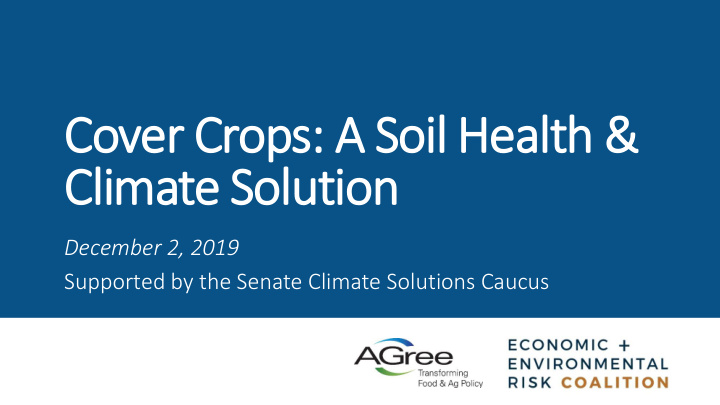



Cover Crops: A Soil Health & Climate Solution December 2, 2019 Supported by the Senate Climate Solutions Caucus
Cover Crops: A Soil Health and Climate Solution December 02, 2019 Rodney Rulon
-4 th Generation family farm -North Central Indiana -100% No-Till since 1989 -Corn-Soybean Rotation -19 years cover crops -Conservation is the best economic model -We are accountable for what leaves our farm We are a Legacy Farm
BUILDING SOIL HEALTH REQUIRES CARBON CAPTURE
CAN WE INCREASE SOIL HEALTH? PLANT COVER CROPS SAME DAY AS HARVEST 5
CAN WE INCREASE SOIL HEALTH? PLANTING CORN AND SOYBEANS INTO GREEN COVER 6
PROVEN CARBON CAPTURE
Increased Yield Drought Tolerance (2012) Resistance to Extreme Weather Nutrient Efficiency and Cycling (Trap Nutrients) Increased water infiltration/water holding Improved Plant Health/Break Disease Cycles Increased Organic Matter Remove Compaction Reduced Erosion
HOW DO WE STOP NUTRIENT LEACHING? COVER CROPS 60% LESS LEACHING Source: Purdue University Dr. Shalamar Armstrong 10
Dr. Eileen Kladivko Agronomy Department
Rulon Enterprises LLC Cover Crop Benefits Fall 2017 Per acre Acres Total Benefit $14.35 5,200 $74,620 Fertilizer Saved-P&K (20#P@$.38 + 30#K@$.225) Fertilizer Saved-N (35#/Acre: 200 versus 165) $7.35 2,600 $19,110 Corn Yield (4yearsx64strips:Plot Data: 7.1bu@$4) $28.40 2,600 $73,840 Soybean Yield Increase (1.95bu@$10) $19.50 2,600 $50,700 TOTAL ANNUAL BENEFIT= $41.98 $218,270 $24.00 2,600 $62,400 Drought Tolerence (2004-17: 30 bu every 5th=6 Bu@$4) Carbon Content (5.35bu/.1 of OM x 50% = 2.7bu@$4) $10.80 5,200 $56,160 Erosion Reduction (2 ton/acre @ $4) $8.00 5,200 $41,600 CSP Program Payment ($40,000) $7.69 5,200 $40,000 TOTAL LONG-TERM BENEFIT= $50.49 $200,160 Total Cover Crop Benefit = $418,430 Net Economic Return = $300,359 ROI = 254% Net Profit/Acre Planted = $57.76 15
You can build HEALTH in your Soil!! Increased Soil Health increases yield (10 bu Corn/ 5 bu Soybeans) $$$ Spent to increase Soil Health is a good investment (254% ROI) Diminished Soil Health will recover faster if you start before it is all gone Land Owners should be asking to see Soil Health reports, not fertilizer tests The Soil Health we leave for the next generation is a lasting Legacy
Rodney Rulon rodney@rulonenterprises.com www.rulonenterprises.com
#WE DIG HEALTHYSOILS Jennifer Nelson Delaware Association of Conservation Districts
Jay Baxter- from “Conventional Farmer” to Soil Health Champion
Snapshots of Delaware’s Soil Health Outreach
Locally Led Conservation • In 2015, Sussex Conservation District developed a custom application program to seed cover crops • Helps to address issues with cost and time constraints
Cover Crops are Trending Upward in DE Delaware Cover Crop Acreage 2005-2018 100,000 80,000 60,000 Acres 40,000 20,000 - FY2005 FY2006 FY2007 FY2008 FY2009 FY2010 FY2011 FY2012 FY2013 FY2014 FY2015 FY2016 FY2017 FY2018 State Funded Federally Funded
T AKING A B IG P ICTURE V IEW ON C OVER C ROPS ROB MYERS, PH.D. UNIVERSITY OF MISSOURI AND NCR-SARE
Photo credit – Edwin Remsburg
Cover crops get rain into the soil Phillips Conservation District
Cover Crops Feed the Soil Biology
From NRCS
Number of Farm Operations Planting Cover Crops in 2017 Data source: 2017 Census of Agriculture
Cover Crop Impacts on Yields and Economic Profitability Over Time Yield Increase Years of cover crops in a field One Year Three Years Five Years Corn -$31.36 $1.42 $17.90 Soybeans -$23.44 $0.42 $10.18
BUILDING SOIL HEALTH AND FARM RESILIENCY
Geospatial data for tracking conservation practices and outcomes Dr. William Salas 12/2/19 Briefing on Cover Crops: A Soil Health and Climate Solution
OpTIS – Satellite-based mapping and monitoring ag conservation practices Operational Tillage Information System OpTIS Row and Grain Crop Management History • Crop History • Crop residue fractions • Tillage Practices • Cover Crop – vigor and termination • Days of green/senescent cover
DNDC – Process-based soil GHG model Modeling Soil Health Outcomes and GHG Emissions Biogeochemical • • Soils SOC Model • • Weather N2O • • Management CH4 DNDC • • Grower GWP • OpTIS • Nitrate leaching • Surveys Environmental Outcomes • Soil Carbon Dr. Changsheng Li • Greenhouse gas emissions (N 2 O, DNDC Model developer SOC, GWP) • Nutrient Use Efficacy • Water Use Efficiency • Reactive Nitrogen
Tracking Soil Health Practices & Outcomes to Support Farmer Centric Ecosystem Service Markets 2 Input to DNDC to model outcomes… 1 Field- level ag management data… • Soils • SOC • Weather • N2O • Management • CH4 • Grower • GWP • OpTIS • Nitrate leaching • Surveys Summarized at the county, watershed, grainshed 3 Set baselines for Supply chain reporting and 4 Ecosystem Service Markets, verify activities/outcomes
Corn Belt Conservation Adoptions and Soil Health Outcomes We analyzed conservation practice adoption and associated outcomes across the Corn Belt for 2005 to 2018 Units: Acres per HUC8 Units kg C/ha
Linking conservation adoption with prevented planting… Prevented Planting was In all three regions, historical use of conservation practices was common in 2019 due to more frequent on those fields that successfully planted in 2019. flooding in the spring Successful Plantings Prevented Plantings Analyzed 3 counties: Red fields were prevented plantings Wood County, OH Green field were successfully planted Hutchinson County, SD Lincoln County, MO Example Lincoln County, MO Planted acres averaged 3 years of historical cover crop. Prevented acres average had essentially no historical cover cropping
Thank you Bill Salas Email: wsalas@daganinc.com Phone: 603-292-1191
Cover Crops: A Soil Health & Climate Solution Supported by the Senate Climate Solutions Caucus
Cover Crop Programs & Incentives AGree 2019 Landscape Assessment covers: Supply Chain Initiatives (6) • Foundation Programs (2) • NGO Programs (3) • • State Programs (29 states) Federal Programs (3) •
Recommend
More recommend